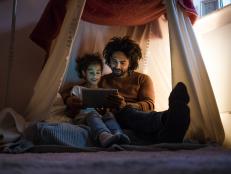10 Tips for Flying with Kids
Essential tips for any traveler with a toddler in tow.

How To Fly with Kids
My mother always used to say that anywhere there was a plane, train or bus taking off, you could probably find me chasing after it. Like many, I have a tough time resisting adventure and love to feel the thrill of experiencing something new. While some may say parenting is the biggest adventure of all, having children definitely changes the way you travel. Infants and toddlers complicate matters when you factor in all the baby gear and the possibility of tiny tempers flaring when things don’t go their way. As with just about every complicated endeavor, the key is to be prepared. Here are 10 ways to make those security lines, layovers and long flights a breeze.
Get In Gear
Veteran international traveler Jessica van Dop DeJesus, founder of food and travel blog The Dining Traveler, took her daughter on her first flight at two months old. The now-two-year-old has been to 10 countries and counting. For really little ones, DeJesus recommends checking strollers and car seats before going through security and wearing your infant in a carrier like her favorite made by Tula. Now that her daughter has grown beyond that stage, DeJesus loves the collapsible, lightweight and relatively inexpensive GoodBaby Pockit stroller, which folds up smaller than a carry-on. And, because her daughter has graduated from the infant car seat, DeJesus now relies on relatives at her destination or car rental companies to provide a safety seat.
Cover Up
If you do check any of your baby gear, DeJesus recommends buying protective coverings that are sold by stores like Amazon and Target.
"People throw your stuff all over," DeJesus says. "It’s nice to have a cover that you’re sure isn’t going to get damaged."
Even when borrowing or renting baby gear upon landing, the bags still come in handy. "We bring the car seat bag with us in our luggage to use for European travel," DeJesus says, noting that they sometimes start in one country and fly to another. Plus, many parents sneak baby clothes and toys into the bags covering the stroller or car seat — or even some of their own heavier items, which helps to get around strict airline weight restrictions for luggage.
The Juggle Is Real
Even without children, getting through security can be a struggle. Add kids to the mix of trying to get your shoes on and off, keeping your pants from falling down while your belt is in the bin and not forgetting your laptop, and you’ve got a pretty stressful situation. DeJesus recommends having all liquids in sealed bags before you leave the house and stowing them in a handy place where you can grab them easily to put in a bin. Another big tip? Be upfront with TSA agents about baby-related items like breast milk and formula.
"It’s stressful, but if you’re explicit with them on what it is, they’re much more flexible about it," she says.
Toddler Time
DeJesus said her biggest advice for travel-loving moms-to-be is to take as many excursions as you can before your beloved babe turns one year old. Once they start walking and talking, parents should expect the challenges to intensify. Be prepared to provide your toddler with undivided attention, since that’s your best bet for keeping them from turning on you, DeJesus cautions.
Pump It Up
When they’re babies, in-flight fussiness can usually be alleviated by walking up and down the aisles while holding them or with a feeding. With toddlers, however, they can be tougher to distract and entertain during long trips.
Before breaking out the pre-loaded iPad, DeJesus uses a combination of books, stuffed animals and walking around the plane to observe the other passengers. Another strategy she uses starts before they leave home.
"Now that [my daughter is] talking and understands, we kind of pump her up about the trip," DeJesus says. When her daughter gets restless, DeJesus asks her to count the other planes or point out the cockpit. This gives her daughter a sense of being a part of the trip.
Food Is Usually the Answer
Packing plenty for everyone to eat is one of the best and easiest ways to avoid a tantrum or distract a wailing child — or even a cranky mom. For infants, nursing or giving them a bottle of formula during take-off and landing can alleviate ear pain from the changing air pressure. For toddlers, offer a sippy cup; for older kids, offer chewing gum. To avoid hunger pangs brought on by irregular schedules and flight delays, make sure you have fruit and veggie pouches on hand. Fruit like apples and bananas travel well, and favorite snacks like granola bars, Goldfish, yogurt-covered raisins or pretzels are always a good bet. Maybe pack a coveted treat that will incentivize good behavior in case of delays.
Timing Is Everything
To make sure her daughter has the best chance of sleeping on the plane and beating jet lag once they land in Europe, DeJesus likes to book overnight flights that board around 6 p.m. and land the next morning.
"We do her bedtime routine on the plane — put on her pajamas, read stories and give her stuffies," DeJesus says. But even though this works like a charm for her daughter, DeJesus notes that parents often don’t get the benefit of the overnight flight. "I used to take an Ambien, go off to sleep and wake up on a different continent, but I can’t do that anymore," she jokes.
Resist The Urge
No matter where you’re headed, a long flight usually means a significant time change — which translates into jet lag. DeJesus has had plenty of experience with this, since she and her husband regularly travel to the Netherlands to visit his family, and DeJesus is a U.S. Marine who lived in Belgium for six years while working for NATO. To speed through the adjustment period as quickly as possible, she recommends resisting the desire to sleep during the first day.
"Even if we’re [exhausted], we try to go through the normal schedule. If you go to sleep, everything is out of whack," she cautions.
Respect the Schedule
Looking back, DeJesus now laughs at how she used to think it was silly to stop everything for a child’s nap during vacation. She now has a much greater respect for nap time, but she and her husband might work in an hour-long walk after lunch to get someplace they want to see, giving Lu the chance for a little snooze in the stroller.
"We try our best to put her down for a nap or keep her sleep schedule," she says. "Keeping some semblance of your daily schedule is really hard, but it pays off."
Create a Seasoned Traveler
DeJesus' daughter is now old enough to carry a backpack with a few of her own things. "We want to instill a sense of responsibility," she says.
DeJesus uses the backpacks with a little "leash" but acknowledges that other people have strong opinions on the product.
She also suggests that parents sign children up for frequent flier accounts starting with their very first flights. "Lifetime miles start at the beginning," she says, noting that the kids will thank you later when they receive perks for hitting milestones like one million miles much sooner than most people.
It Gets Better
I recently survived a trip from Washington, D.C., to Rome with my 8-year-old and 12-year-old. While I’ll never forget the stress and worry of flying with them during the infant and toddler years, those memories feel hazy and distant now. Thankfully, they’ve been replaced by the new reality of my kids being able to carry their own luggage, lend a hand when needed, understand directions quickly during intense periods like TSA screening and boarding and entertain themselves (or sleep) on the flights. So, take heart, fellow parents. It does get better.
YOU MIGHT ALSO LIKE: Kid-Approved Luggage for their Next Adventure, 10 Personalized Travel Gifts We Adore, Best Travel Toys for Toddlers and Preschoolers
















